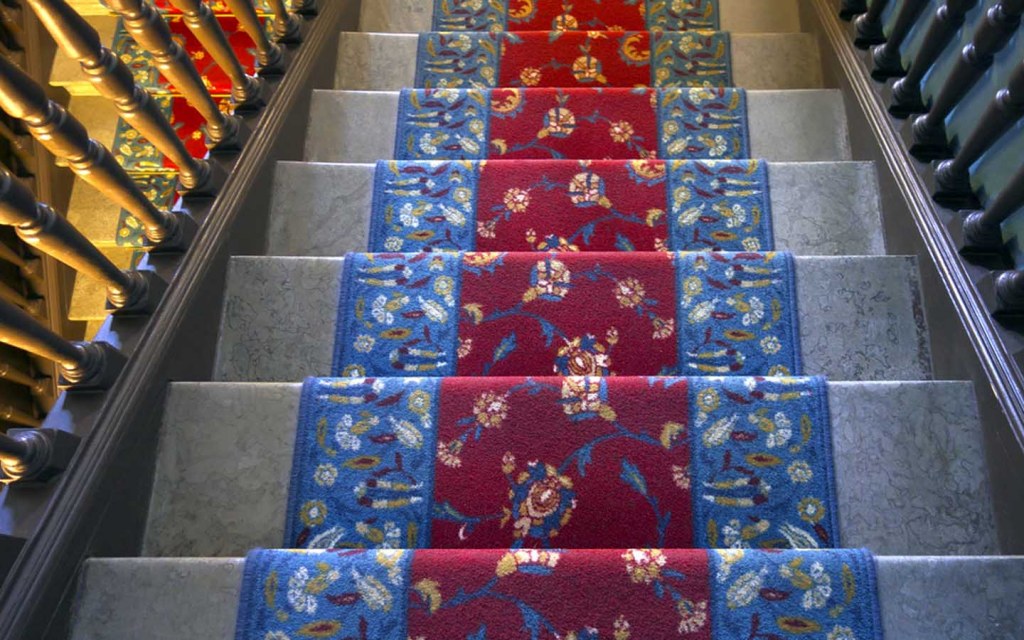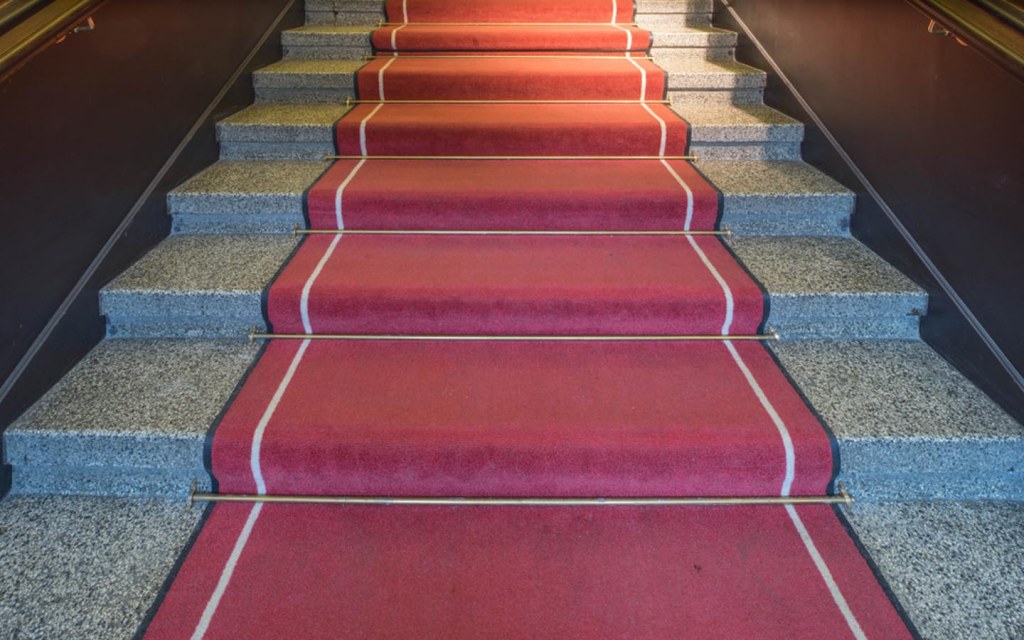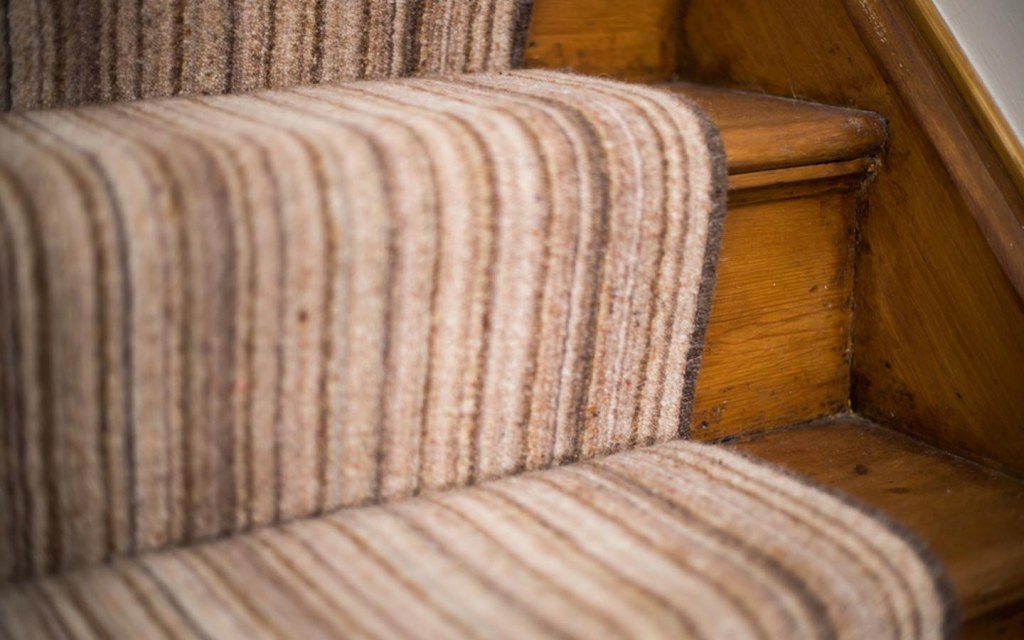Home » Home Decor » Learn How to Install Carpet on Stairs
In This Post
– How to install carpet on marble stairs
– How to install carpet on concrete stairs
– How to install carpet on wooden stairs
A carpeted stairway can make your home look elegant and lavish. Of course, covering your steps with a carpet or a runner can be a little heavy on the pocket since you’ll have to spend a considerable sum on purchasing the material as well as pay a professional to do the job for you. The thing is, carpeting your stairs is not as difficult as it looks. If you follow our DIY guide on how to install carpet on stairs, you can upgrade your entire home décor and give your staircase a stylish makeover all by yourself.
Not to mention, having carpeting on the stairs can soften the look of your home and absorb sound waves. They are also generally safer as you are less likely to slip and lose your balance while climbing carpet-covered steps. In case you fall, carpeted stairs will provide you with much better padding than the cold, hard marble, wooden, or concrete steps.
Most newly constructed homes in Pakistan boast marble or wooden staircases, while older constructions have concrete steps. We’ve discussed the carpet installation process for all three types of stairs in our comprehensive guide.
There are different ways to carpet stairs, but we’ll be discussing the ones that are easiest to follow, even for those who are new to the world of DIY home improvements.
How to Install Carpet on Marble Stairs

Marble stairs have become somewhat of a default fixture in modern houses – and for a good reason. They are easy to clean, less likely to stain, and of course, they give your living space a modern and luxurious look. Covering these stairs with a beautiful carpet runner will only add depth to your décor, along with making the steps safer for everyone in your home.
Materials and Tools Required to Install Carpet on Marble Stairs
Let’s take a look at some of the things you need for carpet installation.
- Carpet runner
- Marble adhesive
- Carpet cutter
- Measuring tape
- Chalk
- Caulking gun (optional)
- Straightedge (optional)
Procedure
Step 1: Measure the stairs to calculate the length of the carpet you’ll need. The width of the carpet depends on whether you want to cover the width of the entire step or want to leave some marble peeking out from both sides and only cover the centre part of the stairs. To install carpet on steps, you can measure the tread and riser for one step in inches and then multiply it with the total number of stairs. If the top and bottom steps measure differently than the rest, you’ll have to add their measurements separately. Then, divide the total number of inches by 12 to get the value in feet.
In case your treads have a moulded edge, also known as the nose, add it to the total value as well.
Step 2: Cut the carpet for installation but add about 20 percent for wastage. For example, if the total length of the carpet required for your staircase is 10 feet, then you should cut 12 feet for installation.
Step 3: Use a measuring tape to locate the centre of the stair’s width and mark it with chalk. You can either mark this point on the top stair or on each step, depending on what seems more convenient to you.
Step 4: Measure the width of the carpet or runner. Then, using the centre point as a guide, mark the points where the outer edges of the carpet will lay on the marble stairs. You can do this with chalk, so it’s easy to remove.
Step 5: For marble, you’ll need to install carpet on stairs with glue. Spread marble adhesive on the stairs using a caulking gun, if available. Starting with the top-most step, put the glue on the tread and riser while staying about an inch with the chalk marks. Don’t forget to run beads of adhesive between the treads and risers of each step. Since the glue tends to dry quickly, it is recommended that you tackle one stair at a time.
Step 6: Keeping in mind the pattern of the carpet, unroll the material so that its back end is facing the steps. Make sure to hold the carpet straight and keep it taut. It is recommended to sit two steps below the stair you are covering so that you can properly lay down the carpet.
Step 7: Press the starting edge of the carpet on the top-most tread and then continue to press it down on the riser. You can either use a straightedge or your fingers to press the carpet to the riser to make sure it sticks properly.
Step 8: Smooth the surface of the carpet with your hands. Starting from the centre, move towards the edge to eliminate any air bubble. Make sure the carpet forms a tight fit against the marble stairs.
Step 9: Repeat this step until you reach the last step. If you are planning to install carpet on stairs landing, leave a few extra inches, and use adhesive to secure it. Cut the rest using a carpet cutter.
Step 10: Allow the marble adhesive to dry completely as per the manufacturer’s instructions. Open the windows and doors for better ventilation, as marble adhesives are generally strong and can produce fumes.
How to Install Carpet on Concrete Stairs

The carpet installation process for concrete stairs isn’t much different from that of a marble staircase. Since marble and wooden stairs are replacing concrete staircases in homes, the most budget-friendly way to upgrade your living space is by covering the steps with a stylish carpet.
Materials and Tools Required to Install Carpet on Concrete Stairs
To install carpet on stairs and landing, you’ll need these materials.
- Concrete mix
- Carpet
- Adhesive
- Trowel
- Carpet cutter
- Chalk
- Measuring tape
- Straightedge (optional)
Procedure
Step 1: Fix the cracks and holes in the concrete steps. You can mix a small batch of concrete and fill these gaps with a trowel. Once all the flaws have been fixed, and the steps look smooth, let the concrete set completely before moving onto the next step. You can also use a grinder to level the surface if needed.
Step 2: Measure the total length of the stairs (treads and risers) in inches and then divide the sum with 12 to get the value in feet. The width of the stairs depends on how much of the area you want to cover.
Step 3: Use chalk to mark the centre of each step and then use it as a guide to mark the outer edges where the carpet will lay.
Step 4: Spread the carpet adhesive on the treads and edges of the concrete stairs with a trowel.
Step 5: Unroll the carpet so that its back is facing the top of the stairs and press it down on the adhesive.
Step 6: Press the material on the treads and risers using your hands or a straightedge. Ensure there aren’t any air bubbles trapped under the surface of the carpet and that it has been fitted tightly against each step.
Step 7: Repeat the process until you reach the bottom of the staircase. Glue the carpet on the landing as per your preference and cut away the rest.
How to Install Carpet on Wooden Stairs

Just like wooden flooring, wooden staircases are also a favourite among homeowners in Pakistan. So, if you wish to enhance the beauty of your stairway with a stunning carpet, here is all you need to know about installing carpet on wooden stairs.
Materials and Tools Required to Install Carpet on Wooden Stairs
Whether you are planning to install or replace carpet on steps, here is a list of tools and materials you’ll need to get the job done.
- Carpet
- Measuring tape
- Carpet cutter
- Tackless carpet strips
- Hammer stapler
- Stair tool
- Straightedge
- Quality padding
Procedure
Step 1: Nail down tackless carpet strip to the back of each step (riser) of your wooden staircase. However, don’t forget to put a thick layer of cardboard between the tackless strip and the baseboard to protect the surface from any damage. These wooden strips have small carpet tacks attached to them, which make installing carpet on wooden stairs much easier. If you are planning to cover the entire step with carpet, attach tackless strips to the walled side of the landing as well. Nail more than one tackless strips to the risers as needed.
Step 2: Measure the stairs (tread + riser) and cut the padding for each step. Carpet padding on stairs increases the material’s life and keep it from wearing out quickly. It also makes the carpet feel soft under your feet. This padding is easily available at hardware stores as well as carpet stores. Please remember that this material should fit between the tackless strips and the bottom of the risers.
Step 3: Attach padding to the stairs by using a hammer stapler. Starting from the middle of each step, staple the padding on the stairs. Make sure to wrap the padding around the nose of the treads perfectly and staple it in place before moving to the next step. This way, you won’t have to deal with any creases or bumps that may become evident once the carpet has been laid.
Step 4: Once the padding has been put in place, measure the stairs once again atop the affixed material, and cut the carpet accordingly. Now, you can either cut the carpet for each step individually or use a long strip. If you decide to cut out separate pieces, add about 5 inches to the measured width, so you have enough material to cover the corners.
Step 5: Unlike installing carpet on marble and concrete stairs, it is recommended to start carpeting a wooden staircase from the bottom-most step and then work your way up.
Unroll the measured carpet and place its end corner on the bottom edge of the stairs. You can use an awl or straightedge to push the carpet into the tackless strips and form clean lines between the riser and the floor. If you are satisfied with the results, staple the carpet to the riser and below the tread.
Step 6: Make sure to stretch your carpet and hold it taut as you fix it into the seam between the riser and tread. You can also use a stair tool to secure the carpet into the seam.
Step 7: Repeat the process until you reach the landing.
Although the process to install carpet on steps may take more than a few hours, the end result will definitely be worth all the hassle.
Meanwhile, you can check out ways to get rid of stains from your carpet, so your stairs will always look clean and well-maintained. On the other hand, if you are in the process of renovating or remodelling your home, you can take a look at our comprehensive guides on the types and rates of wooden flooring as well as different types of tile flooring options in Pakistan.
Stay connected to Zameen Blog, the best home décor and real estate blog in Pakistan, for more DIY home improvement tips and tricks. You can also send us your suggestions and feedback on blog@zameen.com. Moreover, don’t forget to subscribe to our newsletter to stay up-to-date about the latest construction and property trends in the country.



